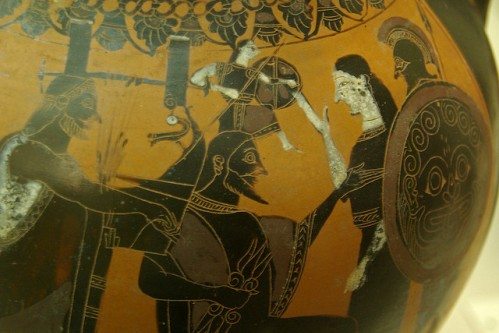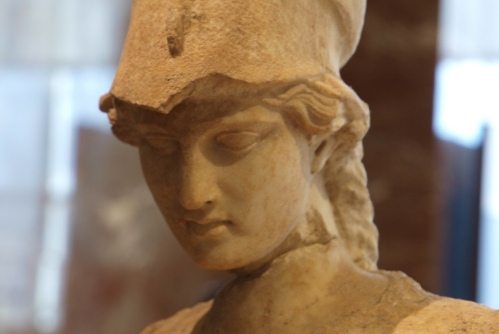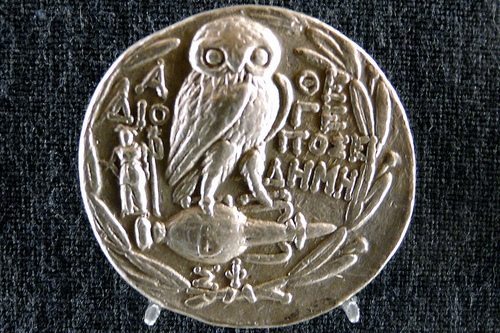The goddess of wisdom and knowledge, the invincible warrior, the protector of cities and the patroness of sciences, Pallas Athena enjoyed well-deserved respect among the ancient Greeks. She was the favorite daughter of Zeus, and it is in her honor that the modern one is named. Pallas Athena helped the heroes of Greece with wise advice and did not leave them in moments of danger. The ancient Greek goddess taught the girls of Greece weaving, spinning and cooking. It is believed that it was Pallas Athena who invented the flute and established the Areopagus (high court).
Appearance of Pallas Athena:
Majestic posture, large gray (and according to some sources, blue) eyes, blond hair - her whole appearance suggests that you have a goddess in front of you. Athena Pallas, as a rule, was depicted in armor and with a spear in her hand.
Symbols and attributes:
Pallas Athena is surrounded by male attributes. On the head is a helmet with a high crest. A shield (aegis) is obligatory present - it is decorated with the head of Medusa Gorgon. The ancient Greek goddess of wisdom Pallas Athena is accompanied by an owl and a snake - symbols of wisdom. It is noted that the goddess of victory, Nike, was her constant companion. The sacred olive tree can also be called a symbol of Pallas.
Pallas Athena is surrounded by male attributes: on her head is a helmet with a high crest, in her hands is a shield adorned with the head of Medusa Gorgon
Strengths of Pallas Athena:
Although Athena was one of the most "sensible" goddesses of the ancient Greek Pantheon, nevertheless, she was characterized by a certain favoritism. This, in particular, is hinted at by the myths of Odysseus and Perseus.
Parents:
Pallas Athena was born unusually and spectacularly. Once Zeus was predicted that his wife, the goddess Metis, would give birth to a son who would be smarter and stronger than his father and would overthrow him. But first, a daughter had to be born. Zeus, not wanting to be overthrown, swallowed the pregnant Metis. Soon he felt a severe headache and ordered Hephaestus to cut his head with an ax. Athena was born from the head of Zeus. The goddess was already fully armed at birth.

The goddess was born from the head of Zeus and was already fully armed at birth
There are other, less common versions of who the parents of the ancient Greek goddess Pallas Athena were. According to some myths, her mother was the nymph of the river Triton, and her father was the god of the seas, Poseidon.
Place of Birth:
It is impossible to unequivocally state exactly where the goddess Pallas Athena was born: different myths point to different places. So, she could be born near Lake Tritonis or the river Triton, in Crete, in the west of Thessaly, in Arcadia, or even in the town of Alalcomene in Boeotia. The most common version is that the birthplace of Athena is still Crete.
Personal life of Pallas Athena:
The goddess Athena Pallas was a virgin and was proud of it. However, she raised an adopted son. That's what the myths say. Once the god of fire Hephaestus turned to Zeus with a request to give him Athena as his wife. Since Zeus had previously promised Hephaestus to fulfill any of his desires, he had no choice but to agree. Yes, the Thunderer had to agree to marry his beloved daughter, but he, nevertheless, advised her to defend herself.

Majestic posture, big gray eyes, blond hair - her whole appearance suggests that you have a goddess in front of you.
According to one version, the ancient Greek goddess of wisdom had to turn to the god of fire for a weapon. Hephaestus, not at a loss, tried to take possession of the goddess. However, the maiden Athena was not going to enter into an intimate relationship - neither with Hephaestus, nor with anyone else. Athena Pallas rushed away from the overly excited god, and he chased after her. When Hephaestus caught up with the maiden, she began to defend herself and even wounded him. Hephaestus spilled the seed on the ground, and soon the baby Erichthonius was born. He was born Gaia - the earth from Hephaestus.
Pallas Athena took Erichthonius under her protection. She fed the baby with her milk and raised him. Erichthonius grew up in her temple and always honored the goddess. It was he who began to hold Panathenaic - festivities in honor of Pallas Athena.
goddess temple
The main sanctuary of ancient Athens and the most beautiful work of ancient art - the temple of the goddess Athena (Parthenon) and today is one of the main visiting cards of Greece. This bright building, as if pierced through by the rays of the sun, rises in the very heart of the ancient city.

The temple of the goddess (Parthenon) is decorated with cutters depicting scenes from her life - one of the main visiting cards of Greece
In the same place - in the Parthenon - was the most famous statue of Pallas Athena by Phidias. Being about 11 m in height, the sculpture was made of gold and ivory on a wooden base. The original of the statue has not survived to this day, but it is known from surviving copies and images on coins.
The main myths about Pallas Athena:
The goddess Athena Pallas is the heroine of many mythological stories.
Among the most famous is the myth of how she gained dominion over Attica, having won the rivalry for the region of Poseidon. Each of the gods made a gift to the city: Poseidon - a water source, Athena - an olive tree. The judges decided that the gift of the goddess is more useful, and gave preference to her. So Pallas Athena won the dispute and became the mistress of Attica, and the city where it all happened was named after her.
Another myth tells how Pallas Athena participated in gigantomachy (battle with giants). On one of the giants, the formidable warrior brought down the island of Sicily, on the other she tore off the skin and covered her own body with it. The details of this battle were depicted on the shield of the statue of Athena.

Frequent companions of the goddess - an owl and a snake - symbols of wisdom, and also Nike - the goddess of victory
Pallas Athena also participated in the Trojan War. She helped the Greeks in every possible way in the capture of Troy, and it is she who is credited with the emergence of the idea that put an end to the long-term siege - about deceiving the Trojans with the help of the Wooden Horse. She prompted Odysseus to place a detachment of Greek soldiers in a huge statue of a wooden horse and leave it at the gates of Troy, while the main forces of the Greeks retreated from Troy, allegedly lifting the siege. The Trojans, after some hesitation, dragged this wooden structure into the city. At night, the soldiers hiding inside the horse came out, opened the city gates and let in their comrades.
